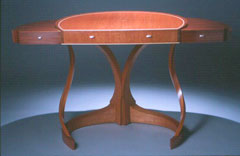
Gaze at Jefferson Shallenberger’s furniture and the word art definitely springs to mind, but it’s not a word he particularly favors. “Art is often used as a pretty arrogant word,” Jeff maintains. “I dance the line between art and furniture.” In his case, it is certainly a fine line.
Jeff does admit that, when designing his pieces, he is far more concerned with appearance than function. “I care less about utility than esthetics,” he says. Sweeping, elegant lines merge in his highly eclectic collection of exquisitely designed pieces, leaving one to wonder from whence come his ideas.
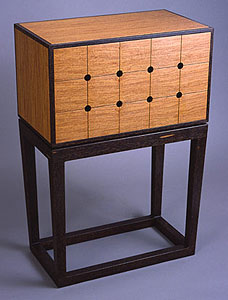
“With commissions, I’ll sometimes start with drawings, but when I can, I design on the fly. Often I’ll start with one specific part, and with only a loose idea as to how the whole piece will look. As it progresses, it sort of tells me what the rest should be like. I appreciate that element of discovery along the way.” Of his own work, his favorites include Red Desk, which he says is the hardest thing he’s made, and White Cabinet, which is peaceful, quiet and something he could live with.
Recently, he got the ultimate commission: one that is completely carte blanche. A customer for whom he’s done other work gave him a check and said “Build me something.” There are no limitations, no instructions, and no strings attached. “I can build any piece of furniture, in any design,” Jeff explained. “At present, I haven’t even thought about what it will be, but it will fit the space and style of the house.”
As is so often the case, he started toward a much different career path before discovering the joys of woodworking. “My grandfather, a professor at Stanford, used to build sailboats,” Jeff told me, “and that was an early woodworking inspiration. However, after graduating from UC Davis, I intended to become a teacher.”
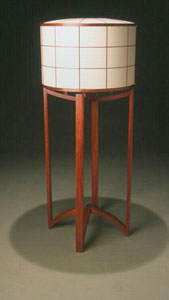
He got sidetracked when he took a summer class at the famed College of the Redwoods, and realized that furniture making was more alluring. “I applied and got into a program there. In the meantime, I started making furniture in my mother’s garage. After a year at Redwoods, I started a woodworking business with a classmate, Nick Clark. We had a business together for three years, but continued to share a shop for two more years after we dissolved the business. Once we split up, I went back to the College of the Redwoods for another year.”
Though the school is often associated with its most renowned teacher, James Krenov, Jeff was quick to point out that the rest of the staff deserves even more credit.”When Krenov waxed about the ‘why’ of woodworking, it was magical,” he admitted, but pointed out that from day to day, Krenov could be both supportive and demoralizing. In contrast, he said, “the rest of the staff was consistent, and great. Without the skills I learned there, I could not be doing the things I am doing now.”
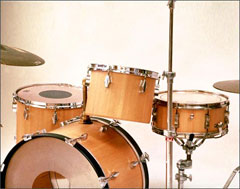
Jeff’s furniture can be peaceful, fascinating and compelling, but at times, it may also be less than practical. His serene White Box is a good example. An austere holly box with a myriad of draws sits atop a tall narra stand, but except for one tiny knob, there are no handles. Lifting the knob reveals a small cage that houses a magnetic “handle” that will in turn open all the other drawers and sections. It’s clever, but as he says, not all that convenient. His Key Cabinet exhibits yet another take on handle-free cases. It’s drawers form a grid with a hole at each intersection, just right for a finger to enter and pull the drawer.
At the other end of the spectrum, he’s also made things that are nothing but practical. A drummer since the age of thirteen, he rebuilt a complete drum set. “Poverty is a great breeder of creativity,” Jeff admitted. “If I can’t buy it, I have to figure out how to make it. I had some downtime, a broken drum set and no money. I took the hardware off the old set, and made new shells.”
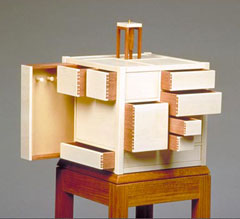
In fact, music is another facet of his artistic temperament. He took piano lessons as a kid, switched to drums, then added guitar in high school. “I wanted to record music, and the songs were a bit thin with drums only,” he quipped. In fact, his hobby is recording music, and he has a small recording studio in his home. “If I were without financial concern,” Jeff confessed, “woodworking would become a hobby, and I would record music instead.”
Still and all, it is obvious that he loves woodworking. “In 11 years of woodworking,” he confessed, “I think I have only had three days when I did not want to go to work.”
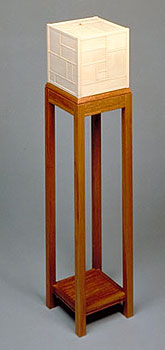
He’s starting to pass that on to others as well; this summer, he helped teach a class at College of the Redwoods, and says he enjoyed that process very much. Jeff suggests that people should “appreciate fine things,” which, of course, inspired me to ask what he meant by “fine things.”
“Things that make you happy, inspire you, feel good and demonstrate a care by their maker. Those things are to be appreciated.” If that is the case, then by his own definition, Jeff’s work certainly fits that vaunted category of “fine things.”





